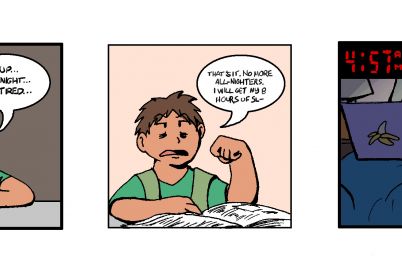
Danganronpa is a Japanese visual novel franchise created by Kazutaka Kodaka and published by Spike Chunsoft in 2010. Photo from gameplay.
Alice McGuire
Deputy Editor
My dad once told me that Superman had taught him how to read–that comic panels had the power to pull readers directly into a story, without the barrier of a wall of text. This was advice that I would return to whenever I found myself in a reading slump.
Maryam Barrie, a professor in the English department, has noticed a similar phenomenon. Barrie, who has incorporated graphic novels in her curriculum since the 90s, stated that, while she has occasionally had students who were confused as to why they were studying comics in a literature course, “Most of the time they’re relieved to be faced with another kind of text by that point in the semester.”
But, when I found myself doomscrolling in lockdown, graphic novels weren’t enough. It was then that I dove into the world of visual novels.
Though technically video games, the gameplay of a visual novel is atypical in that they tend to consist primarily of clicking through text, as though deeply immersed in a 40+ hour PowerPoint slide. They typically feature illustrated character sprites, background art, music and sound effects, and–on occasion–animation and voice acting.
While I would consider reading to be an inherently interactive activity, visual novels often take this a step further by allowing players to make choices that can impact their dynamic with the characters or even the ending that they get.
And, to be clear, not all visual novels play like PowerPoint slides–some incorporate hybrid elements from other genres, such as point-and-click, to create a truly immersive experience.
The medium is most commonly used for dating simulators, where the player romances a wide cast of potential love interests, but it has also proven itself among mystery lovers.
My own preference is for love and mystery to work together, and so my journey is as follows:
“Danganronpa: Trigger Happy Havoc” was my introduction. Featuring pink blood, murderous teddy bears, and a cast of intense personalities pitted against one another, the franchise is as silly as it is engaging and will keep readers up until dawn investigating the crime scene.
“Hatoful Boyfriend” holds the distinction of being the only dating simulator that I have successfully played through. While I was drawn to it for the meme, I remember it for the numerous surprises that the writing threw my way and, in particular, the ending, which unlocks after playing through all routes. It’s absurd but well worth the $2 I paid.
“The House in Fata Morgana” puts players in the shoes of a spirit who has lost its memory and entices them to discover the mysteries of the past. Starring trauma, this gothic work features compelling characters and a truly enchanting art style and soundtrack.
“999: Nine Hours, Nine Persons, Nine Doors” is from the same publisher as “Danganronpa” and features a similar setup of unforgettable characters in a surreal life-or-death scenario, but with a much heavier emphasis on escape room mechanics.
“Umineko: When They Cry – Question arc” is the first half of an epic love letter to the mystery genre, which succeeds through its rich characters and in-depth exploration of generational trauma. Though slow-moving, illustrated in what appears to be MS Paint, and easily spoiled with a Google search (don’t do it!), the series quickly took its place as my all-time favorite work of literature and features a soundtrack that is every bit as complex as the writing.
Going into midterm season, I’ll be playing “428: Shibuya Scramble” in the hopes of keeping my brain from completely scrambling. Or, perhaps I’ll go to the library and pick up a copy of Lauren Redniss’ “Radioactive”–at the recommendation of Professor Barrie. If you’re struggling to read for fun, maybe give a graphic or visual novel a go.


